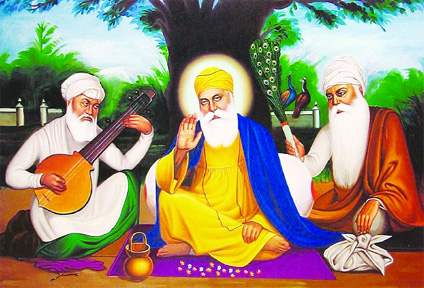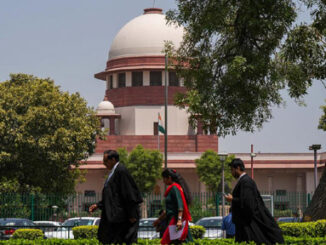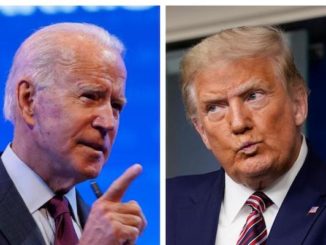
The founder of the Sikh faith, Guru Nanak, was born on April 15, 1469, in the Western Punjab village of Talwandi. He was born to a simple Hindu family. His father Mehta Kalian Das was an accountant in the employment of the local Muslim authorities. From an early age Guru Nanak made friends with both Hindu and Muslim children and was very inquisitive about the meaning of life. At the age of six he was sent to the village school teacher for schooling in reading and writing in Hindi and mathematics. He was then schooled in the study of Muslim literature and learned Persian and Arabic. He was an unusually gifted child who learned quickly and often question his teachers. At age 13 it was time for Guru Nanak to be invested with the sacred thread according to the traditional Hindu custom. At the ceremony which was attended by family and friends and to the disappointment of his family Guru Nanak refused to accept the sacred cotton thread from the Hindu priest. He sang the following poem;
“Let mercy be the cotton, contentment the thread, Continence the knot and truth the twist. O priest! If you have such a thread, Do give it to me. It’ll not wear out, nor get soiled, nor burnt, nor lost. Says Nanak, blessed are those who go about wearing such a thread” (Rag Asa)
As a young man herding the family cattle, Guru Nanak would spend long hours absorbed in meditation and in religious discussions with Muslim and Hindu holy men who lived in the forests surrounding the village. Thinking that if bound in marriage Guru Nanak might start taking interest in household affairs a suitable match was found for him. At age 16 he was married to Sulakhani daughter of a pious merchant. Guru Nanak did not object as he felt that married life did not conflict with spiritual pursuits. Guru Nanak was happily married, he loved his wife and eventually had two sons Sri Chand in 1494 and Lakshmi Chand three years later. Now that he had a family of his own Guru Nanak was persuaded by his parents to take a job as an accountant in charge of the stores of the Muslim governor of Sultanpur Daulat Khan Lodi. Guru Nanak agreed and was joined by his family and an old Muslim childhood friend Mardana, a musician by profession. Guru Nanak would work during the days, but early in the mornings and late at nights, he would meditate and sing hymns accompanied by Mardana on the rabab ( a string instrument). These sessions attracted a lot of attention and many people started joining the two.
Early one morning accompanied by Mardana, Guru Nanak went to the river Bain for his bath. After plunging into the river, Guru Nanak did not surface and it was reported that he must have drowned. The villagers searched everywhere, but their was no trace of him. Guru Nanak was in holy communion with God. The Lord God revealed himself to Guru Nanak and enlightened him. In praise of the Lord, Guru Nanak uttered;
“There is but One God, His name is Truth, He is the Creator, He fears none, he is without hate, He never dies, He is beyond the cycle of births and death, He is self illuminated, He is realized by the kindness of the True Guru. He was True in the beginning, He was True when the ages commenced and has ever been True, He is also True now.” (Japji)
These words are enshrined at the beginning of the Sikh Holy Scriptures, the Guru Granth Sahib. Guru Nanak did not believe in a Trinity of Gods, or the belief that God can be born into human form.
After three days Guru Nanak appeared at the same spot from where he had disappeared. He was no longer the same person he had been, there was a divine light in his eyes and his face was resplendent. He remained in a trance and said nothing. He gave up his job and distributed all of his belongings to the poor. When he finally broke his silence he uttered “There is no Hindu, no Muslim”. Daulat Khan asked what he meant when he said to Guru Nanak, “Perhaps the Hindus were no longer Hindus but the Muslims remain devout to their faith.” Guru Nanak replied,
“Let God’s grace be the mosque, and devotion the prayer mat. Let the Quran be the good conduct. Let modesty be compassion, good manners fasting, you should be a Muslim the like of this. Let good deeds be your Kaaba and truth be your mentor. Your Kalma be your creed and prayer, God would then vindicate your honour.” (Majh)
Guru Nanak was thirty years old at this time in 1499. The next stage of his life began with extensive travels to spread the message of God. Accompanied by his Muslim rabab player Mardana for company, Guru Nanak undertook long journeys to convey his message to the people in the form of musical hymns. Guru Nanak choose this medium to propagate his message because it was easily understood by the population of the time. Wherever he traveled he used the local language to convey his message to the people. He traveled throughout the Indian Subcontinent and further east, west, and north to spread his mission. Wherever he went he set up local cells called manjis, where his followers could gather to recite hymns and meditate.
Once when Guru Nanak came to the small town of Saidpur in West Punjab he choose to stay there with Lalo, a low caste carpenter. At the same time the local chief of the town Malik Bhago, who was quite wealthy and a very proud man was holding a feast to which all holy men were invited. When Malik Bhago found out that Guru Nanak would not attend his feast but instead partook of the simple fare of his host Lalo, he was quite angry and had the Guru brought to him for questioning. When asked why he didn’t join in the feast, the Guru sent for the meal served by Malik Bhago and also some of the simple meal served by Lalo. Holding these in separate hands he squeezed them, blood appeared out of the rich food of Malik Bhago, while milk oozed out of Lalos simple fare. Malik Bhago was put to shame and realized that his riches had been amassed by exploiting the poor, while what Lalo offered was the milk of hard earned honest work.
Another time while camped out at a town during the rainy season, several devotees would come to the Guru on a regular basis. One of them while on the way to see the Guru, came across a prostitute and was allured by her. Thereafter he would leave home on the pretext of going to see the Guru, but instead visited the prostitute. A few days later his friend who daily came to pay homage to the Guru was pricked by a thorn, while his neighbor, who visited the prostitute, found a gold coin in the street. The incident bewildered the Guru’s devotee who came every day religiously. He mentioned it in the morning prayer meeting where Guru Nanak heard it and was amused. He told the Sikh;
“Your friend was destined to come across a treasure but due to his evil ways, it has been reduced to a single coin. While on the account of your past karma you were to have been impaled with a stake, but having reformed yourself, you have been let off with the mere prick of a thorn.” (Janamsakhi)
When the Guru visited Kurukshetra in Haryana, a big fair was being held at the holy tank to celebrate the solar eclipse. There were a large number of pilgrims all over the country. On his arrival at the fair, Guru Nanak had Mardana cook them a meat dish of a deer presented to them by one of his followers. Upon finding that meat was being cooked on the holy premises, a large angry crowd gathered in anger to attack the Guru for what they thought amounted to sacrilege (Bhai Mani Singh, Gyan Ratnavali, pg. 123). Upon hearing the angry crowd Guru Nanak responded;
“Only fools argue whether to eat meat or not. They don’t understand truth nor do they meditate on it. Who can define what is meat and what is plant? Who knows where the sin lies, being a vegetarian or a non- vegetarian?” (Malhar)
When Guru Nanak stopped at Hardwar a pilgrimage center on the Ganges river he found a large gathering of devotees. They were taking ritual baths in the holy river and offering water to the sun. When the Guru asked “Why do you throw water like that?” The pilgrims replied that they were offering it to their ancestors. Guru Nanak upon hearing this started throwing water in the opposite direction towards the west. When the pilgrims asked him what he was doing?. Guru Nanak replied “I am sending water to my farm which is dry”. They asked, “How will water reach you crops so far away?”. Guru Nanak replied, “If your water can reach your ancestors in the region of the sun, why can’t mine reach my fields a short distance away?” The pilgrims realized their folly and fell at the Gurus feet.
On an eastern journey Guru Nanak visited Gorakhmata where he discussed the true meaning of asceticism with some yogis;
“Asceticism doesn’t lie in ascetic robes, or in walking staff, nor in the ashes. Asceticism doesn’t lie in the earring, nor in the shaven head, nor blowing a conch. Asceticism lies in remaining pure amidst impurities. Asceticism doesn’t lie in mere words; He is an ascetic who treats everyone alike. Asceticism doesn’t lie in visiting burial places, It lies not in wandering about, nor in bathing at places of pilgrimage. Asceticism is to remain pure amidst impurities. (Suhi)
After his first long journey, Guru Nanak returned home after twelve years of propagating his message. He then set out on a second journey traveling as far south as Sri Lanka. On his return north he founded a settlement known as Kartarpur (the Abode of God) on the western banks of the Ravi river. Guru Nanak would one day settle down here in his old age. It was also here that he met a young devotee who would later go on to serve five of the following Gurus, Baba Buddha (the revered old one). On his third great journey Guru Nanak traveled as far north as Tibet. Wherever Guru Nanak traveled he always wore a combination of styles worn by Hindu and Muslim holy men and was always asked whether he was a Hindu or Muslim. Guru Nanak visited Sheikh Ibrahim the muslim successor of Baba Farid the great Sufi dervish of the twelfth century at Ajodhan. When asked by Ibrahim which of the two religions was the true way to attain God, Guru Nanak replied; “If there is one God, then there is only His way to attain Him, not another. One must follow that way and reject the other. Worship not him who is born only to die, but Him who is eternal and is contained in the whole universe.”
On his fourth great journey in life Guru Nanak dressed in the blue garb of a Muslim pilgrim traveled to the west and visited Mecca, Medina and Baghdad. Arriving at Mecca, Guru Nanak fell asleep with his feet pointing towards the holy Kabba. When the watchman on his night rounds noticed this he kicked the Guru, saying, “How dare you turn your feet towards the house of God”. At this Guru Nanak woke up and said, “Good man, I am weary after a long journey. Kindly turn my feet in the direction where God is not.” When pilgrims and the holy men of the shrine gathered to hear Guru Nanak and question him, he sang in Persian;
“I beseech you, O Lord! pray grant me a hearing. You are the truthful, the great, the merciful, and the faultless Creator. I know for certain, this world must perish, And death must come, I know this and nothing else. Neither wife, nor son, nor father, nor brothers shall be able to help. I must go in the end, none can undo what is my fate. I have spend days and nights in vanity, contemplating evil. Never have I thought of good; this is what I am. I am ill-starred, miserly, careless, short-sighted, and rude. But says Nanak, I am yours, the dust of the feet of your servants.” (Tilang)
While in Baghdad contradicting the Muslim priests views that their were only seven upper and as many lower regions Guru Nanak shouted out his own prayer saying,
“There are worlds and more worlds below them and there are a hundred thousand skies over them. No one has been able to find the limits and boundaries of God. If there be any account of God, than alone the mortal can write the same; but Gods account does not finish and the mortal himself dies while still writing. Nanak says that one should call Him great, and God Himself knows His ownself.” (Japji)
In 1916 a tablet with the following inscription was uncovered in Baghdad, “In memory of the Guru, the holy Baba Nanak, King of holy men, this monument has been raised anew with the help of the seven saints.” The date on the tablet 927 Hijri corresponds to A.D. 1520-1521.
On his return journey home he stopped at Saidpur in western Punjab during the invasion of the first Mughal Emperor Babar. On seeing the extent of the massacre by the invaders, Mardana asked Guru Nanak why so many innocent people were put to death along with those few who were guilty. Guru Nanak told Mardana to wait under a banyan tree and after a while he would return to answer his question. While sitting under the tree Mardana was suddenly bitten by an ant. In anger Mardana killed as many ants as he could with his feet. Guru Nanak said to him, “You know now Mardana, why do the innocents suffer along with the guilty?”
Guru Nanak and Mardana were both taken prisoner by the Mughal’s. While in jail Guru Nanak sang a divine hymn about the senseless slaughter of the innocents by the Mughal invaders. Upon hearing it the jailer reported it to his king. Babar sent for the Guru and upon hearing him realized that Guru Nanak was a great religious figure. He asked for the Gurus forgiveness and set him free offering him a pouch of hashish. Guru Nanak refused saying the he was already intoxicated with the love and name of God.
After having spent a lifetime of traveling abroad and setting up missions, an aged Guru Nanak returned home to Punjab. He settled down at Kartharpur with his wife and sons. Pilgrims came from far and near to hear the hymns and preaching of the Master. Here his followers would gather in the mornings and afternoons for religious services. He believed in a castless society without any distinctions based on birthright, religion or sex. He institutionalized the common kitchen called langar in Sikhism. Here all can sit together and share a common meal, whether they were kings or beggars.
While working the fields one day in 1532 Guru Nanak was approached by a new devotee who said, “I am Lehna,” Guru Nanak looked at him and replied, “So you have arrived Lehna – the creditor. I have been waiting for you all these days. I must pay your debt.” (“Lehna” in Punjabi means debt or creditor.) Lehna was a great devotee of the Hindu God Durga. One day having hearing about Guru Nanak and his teachings, he decided to visit and see the Guru for himself. Once Lehna met Guru Nanak he left his previous beliefs and became an ardent disciple of the Guru. Lehna’s devotion to Guru Nanak was absolute, when he was not working on the farm, he would devote his spare time to the contemplation of God. Over time he became Guru Nanak’s most ardent disciple. Guru Nanak put his followers to many tests to see who was the most faithful. Once while accompanied by Lehna and his two sons Guru Nanak came across what looked like a corpse covered with a sheet. “Who would eat it?” asked Guru Nanak unexpectedly. His sons refused, thinking that their father was not in his senses. Lehna though agreed and as he removed the cover he found that it was a tray of sacred food. Lehna first offered it to Guru Nanak and his sons and then partook of the leftovers himself. Guru Nanak on seeing this replied;
“Lehna, you were blessed with the sacred food because you could share it with others. If the people use the wealth bestowed on them by God for themselves alone or for treasuring it, it is like a corpse. But if they decide to share it with others, it becomes sacred food. You have known the secret. You are my image.” (Janamsakhi)
Guru Nanak then blessed Lehna with his ang (hand) and gave him a new name, Angad, saying “you are a part of my body”. Guru Nanak placed five coins and a coconut in front of Guru Angad and then bowed before him. He then had Bahi Budhha anoint Angad with a saffron mark on his forehead. When Guru Nanak gathered his followers together for prayers he invited Angad to occupy the seat of the Guru. Thus Guru Angad was ordained as the successor to Guru Nanak. Feeling his end was near, the Hindus said we will cremate you, the Muslims said we will bury you. Guru Nanak said; “You place flowers on either side, Hindus on my right, Muslims on my left. Those whose flowers remain fresh tomorrow will have their way.” He then asked them to prey and lay down covering himself with a sheet. Thus on September 22, 1539 in the early hours of the morning Guru Nanak merged with the eternal light of the Creator. When the followers lifted the sheet they found nothing except the flowers which were all fresh. The Hindus took theirs and cremated them, while the Muslims took their flowers and buried them.
Thus having spread the words of reform throughout his lifetime, Guru Nanak successfully challenged and questioned the existing religious tenants and laid the foundations of Sikhism.





Be the first to comment